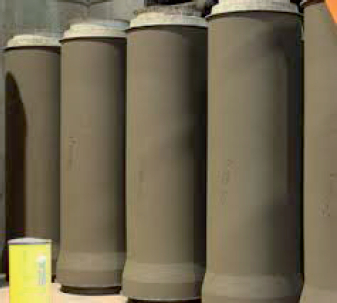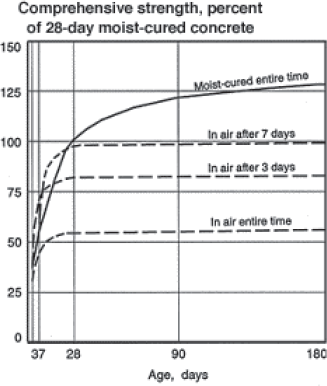Concrete Curing
Concrete Curing
Reprinted from Design and Control of Concrete Mixtures,
Portland Cement Association

Curing ConcreteCuring has a strong influence on properties of hardened concrete such as durability, strength, watertightness, wear resistance, volume stability and resistance to freezing and thawing.
When portland cement is mixed with water, a chemical reaction called hydration takes place. The extent to which this reaction is completed determines the strength, durability and density of the concrete. Most fresh concrete contains considerably more than enough water for complete hydration of the cement; however, any appreciable loss of water by evaporation or otherwise will delay or prevent complete hydration. Since hydration is relatively rapid the first few days after fresh concrete is placed, it is important for the water to be retained during this period, that is, for evaporation to be prevented or at least reduced. The objectives of curing, therefore, are:
- To prevent (or replenish) the loss of moisture.
- To control the concrete temperature for a definite time.
With proper curing, the concrete will become stronger and more resistant to stress, abrasion and frost. The improvement is rapid at early ages but continues more slowly for an indefinite period. For example, Fig. 1 charts the strength gain of concrete with age.
The most effective method for curing concrete depends upon the circumstances. For most jobs, normal curing is adequate but in some cases, such as in hot and cold weather, special care is needed.
When moist curing is interrupted, the development of strength continues for a short period and then stops. However, if moist curing is resumed, strength development will be reactivated. Although it can be done in a laboratory, it is difficult to resaturate concrete in the field. Thus, it is best to moist-cure the concrete continuously from the time it is placed until it has sufficient strength, impermeability and resistance to abrasion, freezing and thawing and chemical attack.
Loss of water will also cause the concrete to shrink, thus creating tensile stresses at the drying surface. If these stresses develop before the concrete has attained adequate tensile strength, surface cracking can result. All exposed surfaces, including exposed edges and joints, must be protected against moisture evaporation.
Hydration proceeds at a much slower rate when the concrete temperature is low. Temperatures below 59°F (10°C) are unfavorable for the development of early strength; below 40°F (4.5°C) the development of early strength is greatly retarded; and at or below freezing temperatures, down to 14°F (-10°C), little or no strength develops. In recent years, a maturity concept has been introduced to evaluate the development of strength when there is variation in the curing temperature of the concrete. “Maturity” is defined as the product of the age of the concrete and it’s average curing temperature. The method is fully described in American Concrete Institute Committee 306 Report, Cold-Weather Concreting. It follows that concrete should be protected so that it’s temperature is kept favorable for hydration, and moisture is not lost during the early hardening period.
 Figure 1. Concrete strength increases with age as long as moisture and a favorible tempterature are present for hydration of cement.
Figure 1. Concrete strength increases with age as long as moisture and a favorible tempterature are present for hydration of cement. Curing Methods and Materials
Concrete can be kept moist (and in some cases at a favorable temperature) by three curing methods:
- Methods that maintain the presence of mixing water in the concrete during the early hardening period. These include ponding or immersion, spraying or fogging and saturated wet coverings. Such methods afford some cooling through evaporation, which is beneficial in hot weather.
- Methods that prevent loss of mixing water from the concrete by sealing the surface. This can be done by covering with impervious paper or plastic sheets, or by applying membrane-forming curing compounds.
- Methods that accelerate strength gain by supplying heat and moisture to the concrete. This is usually accomplished with live steam, heating coils, or electrically heated forms or pads.
The method or combination of methods chosen depends on factors such as availability of curing materials, shape and size of concrete surface, esthetic appearance and economics.